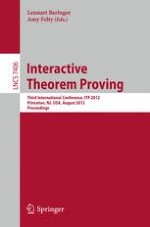This book constitutes the thoroughly refereed proceedings of the Third International Conference on Interactive Theorem Proving, ITP 2012, held in Princeton, NJ, USA, in August 2012. The 21 revised full papers presented together with 4 rough diamond papers, 3 invited talks, and one invited tutorial were carefully reviewed and selected from 40 submissions. Among the topics covered are formalization of mathematics; program abstraction and logics; data structures and synthesis; security; (non-)termination and automata; program verification; theorem prover development; reasoning about program execution; and prover infrastructure and modeling styles.
